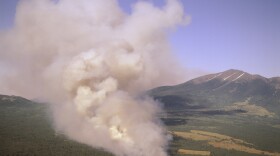A documentary airing on public television stations around the country this month will feature a team of researchers from Northern Arizona University.
Their pioneering work is changing the way scientists understand relationships in nature.
A new field of ecology is budding in the greenhouse at Northern Arizona University. Inside are rows and rows of pots planted with tree cuttings, each less than a foot high.
NAU biology professor Tom Whitham describes the scene:“You’re seeing a couple thousand narrow leaf cottonwood, populus angustifolia.”
A smile forms above his full gray beard when he looks at his trees.
Three decades ago, Whitham began studying cottonwoods.
He formed a global team of researchers called the Cottonwood Ecology Group.
That research has become the foundation for a new field of science.
They call it community and ecosystems genetics.
“Any time you make a change in the genetics of any organism, there are likely to be follow-on consequences (or extended consequences) for other organisms because none of these species live in a vacuum,” Whitham says.
The idea that species are interconnected is not new.
The 19th century naturalist John Muir said when we try to pick out anything by itself, we find it’s bound by a thousand invisible cords.
But Whitham and his team are discovering just how true Muir’s observation is.
NAU’s Idea Lab produced a documentary about Whitham’s work called A Thousand Invisible Cords.
Whitham’s research team discovered that certain species are bigger players than others in an ecosystem.
“If you’re dealing with something like a tree, that we would call a foundation species, it’s the basis of a whole community or ecosystem,” he says.
Cottonwoods, for example, would be a foundation species in a stream setting.
“If we lose cottonwoods, well, the whole community they support will be gone -- microbes, the birds, the mammals, the insects, everything that is associated to one degree or another with those plants,” Whitham says.
And those relationships, Whitham says, are dictated by a specie’s genes.
For example, birds favor cottonwood trees with large branches to build their nests.
Spiders like to spin their webs and catch insects in another species that has thickets.
These branching traits are determined by the internal genetic code of the tree, also called its genotype.
“If you lose certain genotypes -- they either go extinct or we just cut them all down, or a disease knocks them out, or whatever -- if we lose those genotypes, then we lose the organisms that they also support,” Whitham says. “Some community members are so specialized they can only survive on a single tree genotype.”
Instead of studying the genetics of thousands of organisms in an ecosystem, researchers can study complex problems – like global warming -- by focusing on foundation species.
The Cottonwood Ecology Group has harvested thousands of cottonwood tree cuttings from Canada to southern Arizona.
They clone the genetically distinct trees and plant them in sites needing restoration.
But they mix things up, planting cottonwoods from high-altitude Canadian climates into the Arizona desert and vice versa.
“We can discover just how much of a plant’s trait is due to environmental conditions, growing season, temperature, moisture and how much is genetically based,” Whitham says. “We can then zero in on the exact genes that are responsible for those traits. “
And that knowledge could help land managers mitigate the effects of climate change.
It turns out that the genes of some trees enable them to store lots of carbon in their roots.
Some plants are genetically fast growers, making them good biofuel alternatives to carbon –based fossil fuels.
And some genotypes are far more drought tolerant or fire resistant.
As the Earth warms, knowing which genotype of a foundation species to plant in an ecosystem could determine whether hundreds of dependent organisms live or die.
A Thousand Invisible Cords airs in Northern Arizona tonight at 9 on PBS.







